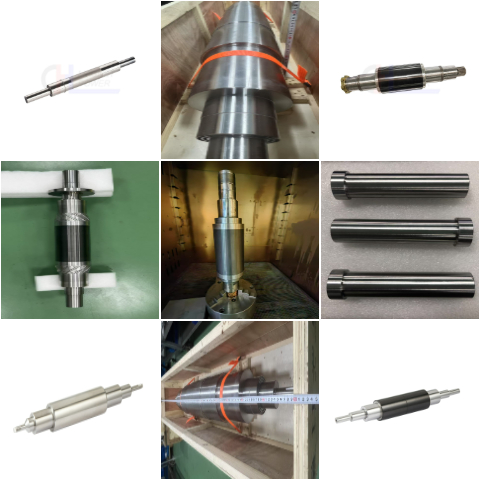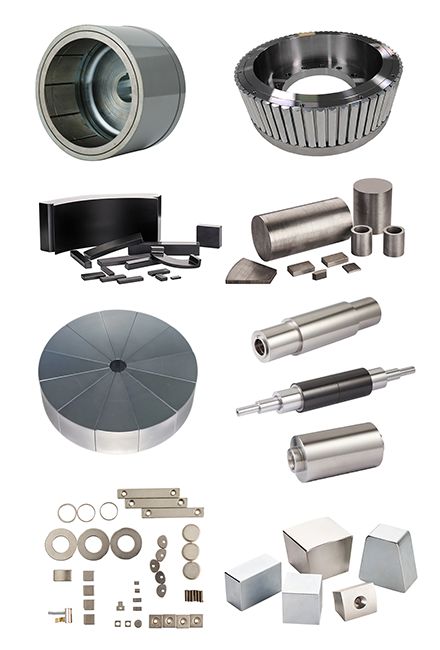
-
By magnet
-
July 17, 2025
- 0 Comment
A Comprehensive Analysis of Permanent Magnet Rotor Production by Hangzhou Magnet Power Technology Co., Ltd.
Hangzhou Magnet Power Technology Co., Ltd. has created a series of high-performance products in the field of permanent magnet rotor production relying on profound technical accumulation and cutting-edge craftsmanship, which are widely used in various industrial application scenarios. The following will elaborate on its entire process from raw material processing to final product delivery.

I. Selection and Proportioning of Raw Materials
(I) Permanent Magnet Materials
When producing permanent magnet rotors, Magnet Power Company accurately selects permanent magnet materials according to the requirements for magnetic properties, temperature resistance, etc., in different application scenarios. For high-temperature and high-reliability demand scenarios, such as aerospace and military fields, samarium-cobalt permanent magnet materials are preferred. Among them, the 2:17 type Sm₂Co₁₇ forms a dual-phase structure of the main phase (Sm₂Co₁₇) and the precipitated phase (SmCo₅) by adding an appropriate amount of Cu, Fe, Zr and other elements (typical ratio is Sm:Co:Fe:Cu:Zr = 2:14:2:1:0.5), which effectively improves the coercivity at high temperatures. For conventional high-performance requirements, such as new energy vehicle drive motors and industrial servo motors, neodymium-iron-boron permanent magnet materials are the main choice. The coercivity is improved by reasonably adding dysprosium (Dy) and terbium (Tb), and the temperature stability is improved by adding cobalt (Co) and aluminum (Al).
(II) Other Materials
The rotor shaft is made of high-quality alloy steel to ensure high mechanical strength and good machinability, meeting the torque transmission requirements under different working conditions. In the selection of silicon steel sheets for laminated rotor cores, materials with low hysteresis loss and eddy current loss are used to reduce energy loss during motor operation and improve overall efficiency.
II. Production and Manufacturing Process
(I) Melting and Powder Making
- Melting process: Put the raw materials with precise proportion into a vacuum induction furnace and melt them at a high temperature of 1400 – 1600℃ (the melting temperature of samarium-cobalt materials is about 1500 – 1600℃, and that of neodymium-iron-boron is about 1400 – 1500℃) to ensure uniform fusion of alloy components. Some neodymium-iron-boron production adopts the “strip casting method”, in which the molten alloy passes through a high-speed rotating copper roller at a cooling rate of 10⁶℃/s to form a thin sheet with a thickness of 0.1 – 0.5mm, providing a master alloy with uniform structure for subsequent powder making.
- Powder making process: The smelted alloy ingot is first crushed by the “hydrogen decrepitation method”. Using the hydrogen absorption and embrittlement characteristics of rare earth alloys, it is crushed into 100 – 300μm coarse powder. Then, ultra-fine grinding is carried out by a jet mill under the protection of inert gas to refine the coarse powder particle size to 3 – 5μm, and the particle size uniformity is strictly controlled within ±0.5μm, laying a foundation for obtaining high magnetic performance permanent magnets.
(II) Forming and Sintering
- Orientation forming: Put the prepared permanent magnet powder into a mold and perform dry pressing or isostatic pressing in a 1.5 – 3T strong magnetic field. Through the action of the magnetic field, the easy magnetization direction of the powder particles is highly consistent (orientation degree ≥ 90%), improving the remanence and magnetic energy product of the permanent magnet. For example, in the production of samarium-cobalt permanent magnet rotors, isostatic pressing is used, and the pressure is controlled at 200 – 300MPa to ensure that the internal structure of the magnet is tight and the orientation is regular.
- Sintering process: The formed green body is sintered in a sintering furnace with a vacuum degree of ≤10⁻⁴Pa. Samarium-cobalt permanent magnet 2:17 type is sintered at 1200 – 1250℃ for 4 – 6 hours, and neodymium-iron-boron permanent magnet is sintered at 1050 – 1100℃ for 2 – 4 hours, promoting diffusion welding of powder particles to form a dense alloy structure with a density of more than 95% of the theoretical value.
(III) Rotor Assembly
- Rotor core production: The rotor core is made of thin silicon steel sheets by lamination. Magnet Power Company uses high-precision automated equipment for lamination operations. The thickness of silicon steel sheets is precisely controlled at 0.25 – 0.35mm. During the lamination process, the pressure and gap are strictly controlled to ensure the adhesion and compactness between the chips, ensure the uniform and stable magnetic permeability of the core, and reduce hysteresis and eddy current losses.
- Permanent magnet assembly: According to the rotor design, the sintered permanent magnets are accurately assembled into the corresponding positions of the rotor core. For some high-performance requirements, a segmented magnet design is adopted, in which the magnet is cut into 3 – 6 segments along the circumferential direction (each segment width ≤ 5mm), and high-temperature resistant insulating materials (such as mica sheets, ceramic fibers) are filled between the segments to effectively block the eddy current path and reduce eddy current loss.
- Connection between shaft and core: The rotor shaft and rotor core are tightly connected by a combination of hot pressing and cold pressing technologies. For example, the rotating shaft is cold-processed and the rotor core is hot-processed at the same time, and then the rotating shaft is pressed into the shaft hole of the rotor core in a sleeve manner to ensure a firm connection, high concentricity during operation, and reduce vibration and noise.
III. Product Testing Links

(I) Magnetic Performance Testing
Professional magnetic performance testing equipment is used to accurately test key magnetic performance indicators of permanent magnet rotors, such as remanence (Br), coercivity (Hc), and magnetic energy product. The magnetic performance stability is tested in different temperature environments (simulating actual application conditions) to ensure that the magnetic performance of the product meets strict standards throughout its life cycle. For example, for samarium-cobalt permanent magnet rotors used in high-temperature applications, at a high temperature of 300℃, it is tested whether its coercivity remains ≥12kOe and whether the magnetic energy product retention rate reaches more than 85% of room temperature.
(II) Structure and Size Testing
High-precision measuring instruments are used to comprehensively test the overall structural integrity and dimensional accuracy of the rotor. Ensure that the coaxiality between the rotor shaft and the core, the assembly position accuracy of the permanent magnet, etc., meet the design requirements, and avoid problems such as unbalanced operation and friction with the stator caused by dimensional deviations. Non-destructive testing technology is used to detect whether there are cracks and other defects inside the rotor to ensure product reliability.
(III) Dynamic Balance Testing
The rotor is installed on a professional dynamic balancing machine, and the weight distribution and center of gravity position of the rotor are accurately measured through high-speed rotation and oscillation. According to the test results, the rotor is weighted or de-weighted to optimize the rotational balance and vibration damping of the rotor, ensure stable motor operation, and reduce mechanical wear and energy consumption.
IV. Packaging and Shipping Process

(I) Protective Packaging
Magnet Power Company carries out all-round protective packaging for qualified permanent magnet rotors after testing. First, apply special anti-rust oil on the rotor surface to form a protective film to prevent oxidation and rust during transportation and storage. Then, use customized foam liners and high-strength cartons for packaging to ensure that the rotor is fully buffered and protected during transportation to avoid collision damage. For export products, the packaging design is strictly in accordance with international transportation standards.
(II) Logistics and Distribution
Relying on Hangzhou’s convenient sea, land and air transportation network and the geographical advantage of being close to Shanghai Port and Ningbo Port, Magnet Power Company closely cooperates with professional logistics partners, selects the most suitable transportation method according to customer needs, and ensures that products are delivered to all parts of the world efficiently and safely. Provide real-time logistics information tracking service, allowing customers to keep abreast of the cargo transportation status at any time.
V. Product Application Scenarios

(I) New Energy Vehicle Field
Permanent magnet rotors are widely used in new energy vehicle drive motors. With their high power density and high efficiency characteristics, they effectively improve vehicle range and power performance. For example, in pure electric vehicles, the drive motor permanent magnet rotor helps to achieve fast response torque output, meeting the needs of vehicle acceleration, climbing and other different working conditions; in hybrid vehicles, the permanent magnet rotor of the auxiliary motor helps the engine and motor work efficiently in coordination, reducing fuel consumption and emissions.
(II) Industrial Automation Field
In industrial servo motors, Cijuli permanent magnet rotors provide precise power control for equipment such as CNC machine tools, robot joints, and precision conveyors with their fast response speed and high control accuracy. In equipment such as industrial pumps and fans, replacing traditional asynchronous motor rotors greatly reduces energy consumption and improves energy utilization efficiency in industrial production processes.
(III) Aerospace and Military Fields
In key equipment such as aero-engine starter motors, UAV drive motors, and military radar servo motors, Hangzhou Cijuli’s permanent magnet rotors, especially high-temperature resistant and high-reliability samarium-cobalt permanent magnet rotors, meet the strict requirements for motor performance in extreme environments, ensure stable operation of equipment, and provide solid support for national defense security and aerospace development.
(IV) Home Appliances and Consumer Electronics Field
In home appliances such as refrigerator compressors, washing machine motors, and air conditioner fans, permanent magnet rotors achieve efficient and energy-saving operation, reducing household electricity costs. In consumer electronics such as drones, floor sweepers, and power tools, they improve product portability and usability with their small size and high torque characteristics.


